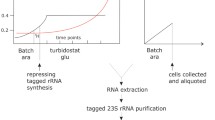Summary
Expression of resistance to erythromycin in Escherichia coli, caused by an altered L4 protein in the 50S ribosomal subunit, can be masked when two additional ribosomal mutations affecting the 30S proteins S5 and S12 are introduced into the strain (Saltzman, Brown, and Apirion, 1974). Ribosomes from such strains bind erythromycin to the same extent as ribosomes from erythromycin sensitive parental strains (Apirion and Saltzman, 1974).
Among mutants isolated for the reappearance of erythromycin resistance, kasugamycin resistant mutants were found. One such mutant was analysed and found to be due to undermethylation of the rRNA. The ribosomes of this strain do not bind erythromycin, thus there is a complete correlation between phenotype of cells with respect to erythromycin resistance and binding of erythromycin to ribosomes.
Furthermore, by separating the ribosomal subunits we showed that 50S ribosomes bind or do not bind erythromycin according to their L4 protein; 50S with normal L4 bind and 50S with altered L4 do not bind erythromycin. However, the 30s ribosomes with altered S5 and S12 can restore binding in resistant 50S ribosomes while the 30S ribosomes in which the rRNA also became undermethylated did not allow erythromycin binding to occur.
Thus, evidence for an intimate functional relationship between 30S and 50S ribosomal elements in the function of the ribosome could be demonstrated. These functional interrelationships concerns four ribosomal components, two proteins from the 30S ribosomal subunit, S5, and S12, one protein from the 50S subunit L4, and 16S rRNA.
Similar content being viewed by others
References
Apirion, D.: Altered ribosomes in a suppressor strain of Escherichia coli. J. molec. Biol. 16, 285–301 (1966)
Apirion, D.: Three genes that affect Escherichia coli ribosomes. J. molec. Biol. 30, 255–275 (1967)
Apirion, D., Saltzman, L.: Functional interdependence of 50S and 30S ribosomal subunits. Molec. gen. Genet. 135, 11–18 (1974)
Apirion, D., Schlessinger, D.: Reversion from streptomycin dependence in Escherichia coli by a further change in the ribosome. J. Bact. 94, 1275–1276 (1967)
Bollen, A., Helser, T., Yamada, T., Davies, J.: Altered ribosomes in antibiotic-resistant mutants of E. coli. Cold Spr. Harb. Symp. quant. Biol. 34, 95–100 (1969)
Brown, M.E., Apirion, D.: Mapping a cluster of ribosomal genes in Escherichia coli. Molec. gen. Genet. 133, 317–327 (1974)
Brownstein, B.L., Lewandowski, L.J.: A mutation suppressing streptomycin dependence. I. An effect of ribosome function. J. Molec. Biol. 25, 99–109 (1967)
Hasenbank, R., Guthrie, C., Stoffler, G., Wittmann, H.G., Rosen, L., Apirion, D.: Electrophoretic and immunological studies on ribosomal proteins of 100 Escherichia coli revertants from streptomycin dependence. Molec. gen. Genet. 127, 1–18 (1973)
Helser, T.L., Davies, J.E., Dahlberg, J.E.: Change in methylation of 16S ribosomal RNA associated with mutation to kasugamycin resistance in Escherichia coli. Nature (Lond.) New Biol. 233, 12–14 (1971)
Helser, T.L., Davies, J.E., Dahlberg, J.E.: Mechanism of kasugamycin resistance in Escherichia coli. Nature (Lond.) New Biol. 235, 6–9 (1972)
Lennette, E.T., Apirion, D.: Genetic analysis of an Escherichia coli syndrome. J. Bact. 108, 1322–1328 (1971)
Mao, J.C.H., Putterman, M.: The intermolecular complex of erythromycin and ribosome. J. molec. Biol. 44, 347–361 (1969)
Otaka, E., Teraoka, H., Tamaki, M., Tanaka, K., Osawa, S.: Ribosomes from erythromycin-resistant mutants of Escherichia coli Q13. J. molec. Biol. 48, 499–510 (1970)
Ozaki, M., Mizushima, S., Nomura, M.: Identification and functional characterization of the protein controlled by the streptomycin-resistant locus in E. coli. Nature (Lond.) 222, 333–339 (1969)
Pestka, S.: Binding of [14C] erythromycin to Escherichia coli ribosomes. Antimicro. agents Chemot. 6, 474–478 (1974)
Saltzman, L., Brown, M., Apirion, D.: Functional interdependence among ribosomal elements as revealed by genetic analysis. Molec. gen. Genet. 133, 201–207 (1974)
Staehelin, T., Maglott, D.R.: Preparation of Escherichia coli ribosomal subunits active in polypeptide synthesis. In: Methods in enzymology, Vol. XX. K. Moldave and L. Grossman, eds., pp. 449–456. New York: Academic Press 1971
Vogel, Z., Vogel, T., Zamir, A., Elson, D.: Correlation between the peptidyl transferase activity of the 50S ribosomal subunit and the ability of the subunit to interact with antibiotics. J. molec. Biol. 60, 339–346 (1971)
Wittmann, H., Stöffler, G., Apirion, D., Rosen, L., Tanaka, K., Tamaki, M., Takata, R., Dekio, S., Otaka, E., Osawa, S.: Biochemical and genetic studies on two different types of erythromycin resistant mutants of Escherichia coli with altered ribosomal proteins. Molec. gen. Genet. 127, 175–189 (1973)
Author information
Authors and Affiliations
Additional information
Communicated by E. Bautz
Rights and permissions
About this article
Cite this article
Saltzman, L., Apirion, D. Binding of erythromycin to the 50S ribosomal subunit is affected by alterations in the 30S ribosomal subunit. Molec. Gen. Genet. 143, 301–306 (1976). https://doi.org/10.1007/BF00269407
Received:
Issue Date:
DOI: https://doi.org/10.1007/BF00269407



